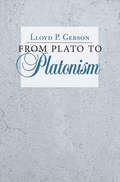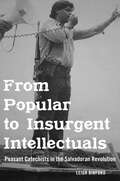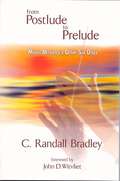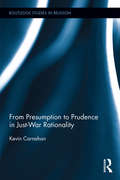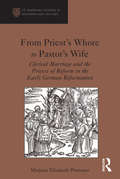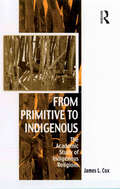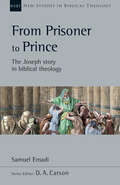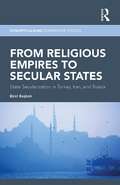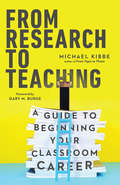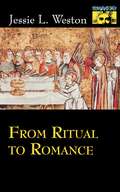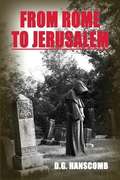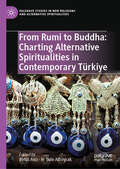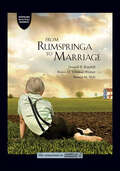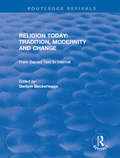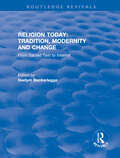- Table View
- List View
From Plato to Platonism
by Lloyd P. GersonWas Plato a Platonist? While ancient disciples of Plato would have answered this question in the affirmative, modern scholars have generally denied that Plato’s own philosophy was in substantial agreement with that of the Platonists of succeeding centuries. In From Plato to Platonism, Lloyd P. Gerson argues that the ancients are correct in their assessment. He arrives at this conclusion in an especially ingenious manner, challenging fundamental assumptions about how Plato’s teachings have come to be understood. Through deft readings of the philosophical principles found in Plato's dialogues and in the Platonic tradition beginning with Aristotle, he shows that Platonism, broadly conceived, is the polar opposite of naturalism and that the history of philosophy from Plato until the seventeenth century was the history of various efforts to find the most consistent and complete version of "anti-naturalism." Gerson contends that the philosophical position of Plato—Plato’s own Platonism, so to speak—was produced out of a matrix he calls "Ur-Platonism." According to Gerson, Ur-Platonism is the conjunction of five "antis" that in total arrive at anti-naturalism: anti-nominalism, anti-mechanism, anti-materialism, anti-relativism, and anti-skepticism. Plato’s Platonism is an attempt to construct the most consistent and defensible positive system uniting the five "antis." It is also the system that all later Platonists throughout Antiquity attributed to Plato when countering attacks from critics including Peripatetics, Stoics, and Sceptics. In conclusion, Gerson shows that Late Antique philosophers such as Proclus were right in regarding Plotinus as "the great exegete of the Platonic revelation."
From Politics to the Pews: How Partisanship and the Political Environment Shape Religious Identity (Chicago Studies In American Politics Ser.)
by Michele F. MargolisOne of the most substantial divides in American politics is the “God gap.” Religious voters tend to identify with and support the Republican Party, while secular voters generally support the Democratic Party. Conventional wisdom suggests that religious differences between Republicans and Democrats have produced this gap, with voters sorting themselves into the party that best represents their religious views. Michele F. Margolis offers a bold challenge to the conventional wisdom, arguing that the relationship between religion and politics is far from a one-way street that starts in the church and ends at the ballot box. Margolis contends that political identity has a profound effect on social identity, including religion. Whether a person chooses to identify as religious and the extent of their involvement in a religious community are, in part, a response to political surroundings. In today’s climate of political polarization, partisan actors also help reinforce the relationship between religion and politics, as Democratic and Republican elites stake out divergent positions on moral issues and use religious faith to varying degrees when reaching out to voters.
From Popular to Insurgent Intellectuals: Peasant Catechists in the Salvadoran Revolution
by Leigh BinfordFrom Popular to Insurgent Intellectuals explains how a group of Catholic lay catechists educated in liberation theology came to take up arms and participate on the side of the rebel FMLN during El Salvador’s revolutionary war (1980-92). In the process they became transformed from popular intellectuals to insurgent intellectuals who put their organizational and cognitive skills at the service of a collective effort to create a more egalitarian and democratic society. The book highlights the key roles that peasant catechists in northern Morazán played in disseminating liberation theology before the war and supporting the FMLN during it—as quartermasters, political activists, and musicians, among other roles. Throughout, From Popular to Insurgent Intellectuals highlights the dialectical nature of relations between Catholic priests and urban revolutionaries, among others, in which the latter learned from the former and vice-versa. Peasant catechists proved capable at making independent decisions based on assessment of their needs and did not simply follow the dictates of those with superior authority, and played an important role for the duration of the twelve-year military conflict.
From Possession to Freedom: The Journey Of Nili-nilakeci
by R UmamaheshwariThe Tamil text, Nilakeci, dated around the 5th century CE (debated), is an unusual literary creation. It retrieves a violent, vengeful pey (female possessing spirit) of Palayanur, transforming her into a Jaina philosopher. It was a profoundly subversive idea of its time, using the female persona and voice (for a hitherto disembodied being) to debate with preceptors of different schools of thought/religions of the time, all male, barring the Buddhist nun, Kuṇṭalakeci. Nilakeci's debates focus on questions of non-violence, existence of the soul, authorship and caste, among others. However, in order to truly appreciate this alter-texting, one has to unravel layers of other texts and traditions: the lesser known villuppattu (bow-song) and natakam (theatrical) versions of the pey Nili stories, as well as the story of Kuṇṭalakeci's own transformative journey. Umamaheshwari situates these in a comparative context, while maintaining the centrality of the debates within Nilakeci, using translation of selected excerpts.
From Postlude to Prelude: Music Ministry's Other Six Days
by C. Randall BradleyJohn Witvliet says: "Business leaders have ‘best practices books’ by the hundreds. Lawyers, doctors, and pastors have them by the dozens. Now those of us in Church music have at least one!" C. Randall Bradley is Professor of Church Music and Director of the Church Music Program and Center for Christian Music Studies at Baylor University. His classroom teaching and practical experience inspire this book. It includes sections on Philosophical/Theological Issues; Personal Issues; Employment and Vocational Issues; Working with Church Staff; Involving Others; Promotion; Organization and Time Management; Facilities and Purchases; Dealing with Transition; and Ministering in Special Situations. There are also helps on Working with Committees and Working with Difficult People, Housing Allowances, Social Security Taxes, Financial Management, and Avoiding Burnout. There is a Minister’s Compensation Worksheet, a Minister’s Housing Allowance Worksheet, and an extensive Bibliography and Index. The material will help you negotiate all those "nitty-gritty" details that fill your days from Monday to Saturday. This book will help not only those who have been in Music Ministry for a while, but also those who are just starting their careers. Church Music classes will find From Postlude to Prelude invaluable.
From Poverty to Power
by James AllenA Book for all those who are in search of better conditions, wider freedom, and increased usefulness. - James Allen
From Preachers to Suffragists: Woman's Rights and Religious Conviction in the Lives of Three Nineteenth-Century American Clergywomen
by Beverly Zink-SawyerThe women's rights movement in nineteenth-century America has primarily been interpreted as a secular movement. However, in From Preachers to Suffragists, Beverly Zink-Sawyer examines the lives of three nineteenth-century clergywomen--Antoinette Brown Blackwell, Olympia Brown, and Anna Howard Shaw--who, seeing their calling to the suffrage movement as an extension of their call to ministry, left the parish to join and become leaders in the movement. Zink-Sawyer tells the stories of their courageous lives, quoting their sermons and writings and tracing their struggles before and after ordination. In doing so, she persuasively demonstrates the vital importance of these leaders--of their religious rhetoric and their theological leadership--in shaping the movement as a whole, reclaiming its religious roots and making a major, even corrective, contribution to American history.
From Presumption to Prudence in Just-War Rationality (Routledge Studies in Religion)
by Kevin CarnahanFor the last several decades, the Just-War debate amongst theologians has been dominated by two accounts of moral rationality. One side assumes a presumption against harm (PAH), and the other identifies with a presumption against injustice (PAI). From Presumption to Prudence in Just-War Rationality argues that the time has come to leave behind these two viewpoints in favour of a prudentially grounded approach to Just-War thinking. In Parts 1 and 2 of the book, Kevin Carnahan offers immanent critiques of the PAI and PAH positions. In Part 3, utilising Paul’s treatment of the atonement and use of the idea of the imitation of Christ, he lays out an alternative to the ways in which theologians in favour of the PAI or PAH have construed the Christian narrative. In Part 4, Carnahan then develops a neo-Aristotelian account of prudence as a higher order virtue governing the interpretation of moral reality. Drawing on this account, he explores what Just-War rationality would look like if it were prudentially grounded. The work concludes with a case study on noncombatancy in the 2011 Israeli bombardment of Gaza. This book offers a compelling new perspective on this important and pertinent subject. As such, academics and students in Religion, Theology, Philosophy, Ethics and Political Theory will all find it an invaluable resource on Just-War theory.
From Priest's Whore to Pastor's Wife: Clerical Marriage and the Process of Reform in the Early German Reformation (St Andrews Studies In Reformation History Ser.)
by Marjorie Elizabeth PlummerOn 13 June 1525, Martin Luther married Katharina von Bora, a former nun, in a private ceremony officiated by city preacher Johann Bugenhagen. Whilst Luther was not the first former monk or Reformer to marry, his marriage immediately became one of the iconic episodes of the Protestant Reformation. From that point on, the marital status of clergy would be a pivotal dividing line between the Catholic and Protestant churches. Tackling the early stages of this divide, this book provides a fresh assessment of clerical marriage in the first half of the sixteenth century, when the debates were undecided and the intellectual and institutional situation remained fluid and changeable. It investigates the way that clerical marriage was received, and viewed in the dioceses of Mainz and Magdeburg under Archbishop Albrecht of Brandenburg from 1513 to 1545. By concentrating on a cross-section of rural and urban settings from three key regions within this territory - Saxony, Franconia, and Swabia - the study is able to present a broad comparison of reactions to this contentious issue. Although the marital status of the clergy remains perhaps the most identifiable difference between Protestant and Roman Catholic churches, remarkably little research has been done on how the shift from a "celibate" to a married clergy took place during the Reformation in Germany or what reactions such a move elicited. As such, this book will be welcomed by all those wishing to gain greater insight, not only into the theological debates, but also into the interactions between social identity, governance, and religious practice.
From Primitive to Indigenous: The Academic Study of Indigenous Religions (Vitality of Indigenous Religions)
by James L. CoxThe academic study of Indigenous Religions developed historically from missiological and anthropological sources, but little analysis has been devoted to this classification within departments of religious studies. Evaluating this assumption in the light of case studies drawn from Zimbabwe, Alaska and shamanic traditions, and in view of current debates over 'primitivism', James Cox mounts a defence for the scholarly use of the category 'Indigenous Religions'.
From Prisoner to Prince: The Joseph Story in Biblical Theology (New Studies in Biblical Theology #Volume 59)
by Samuel EmadiThe story of Joseph is prominent in the book of Genesis and yet is rarely mentioned in the rest of Scripture.Messianic interpretations of the Joseph narrative have often lacked methodological rigor or have simply failed to make a convincing case. Most often interpreters have simply noted historical correspondences between Joseph and Jesus, without considering the narrative's function in the context of Genesis, its redemptive-historical significance, or its appropriation by later biblical authors.In this New Studies in Biblical Theology volume, Samuel Emadi offers a more comprehensive canonical treatment of the Joseph narrative. He considers Genesis 37–50 in its own literary and theological context, intra-canonical development of the Joseph story via inner-biblical allusion, and New Testament references and allusions. Emadi defends the notion that Joseph functions as the resolution to the plot of Genesis and that this story typologically influences how later biblical authors narrate redemptive history, culminating in the New Testament's portrayal of Jesus as an antitypical, new and final Joseph.Addressing key issues in biblical theology, the works comprising New Studies in Biblical Theology are creative attempts to help Christians better understand their Bibles. The NSBT series is edited by D. A. Carson, aiming to simultaneously instruct and to edify, to interact with current scholarship and to point the way ahead.
From Public Policy to Family Dynamics: A Case Study of the Impact of Public Policy on Two 20th Century Jewish Immigrant Families (SpringerBriefs in Social Policy)
by Sana LoueThis compact book relies on the story of two intertwined Jewish immigrant families to tell a multigenerational Jewish story about the interplay between public/social policy, cultural categories, and the lived experience of working class immigrant Jews from Eastern Europe, including trans-/intergenerational trauma. Importantly, it focuses on the impacts of pre-Holocaust public policy, a significant departure from the Holocaust and post-Holocaust focus of much of the published literature relating to Jewish intergenerational trauma. As such, it offers the possibility of better understanding the far-reaching and perhaps unforeseen impacts of public policy. This book addresses events on both the micro and macro levels and is biographical, autobiographical, and historical in its scope. Sources for this work include archival materials, census records, maps, military records, birth and death certificates, congressional materials, newspaper articles, films, images, interviews with living family members, and secondary sources. Among the topics covered are: Russian, Soviet, and U.S. Eugenics: Family Internalization of Policy and Rhetoric The Intertwined Impact of Economics, Eugenic Policy, and Immigration Restrictions The Present Past: Policy, Identity, and Progeny From Public Policy to Family Dynamics: A Case Study of the Impact of Public Policy on Two 20th Century Jewish Immigrant Families adds a human face to writings related to public/social policy. As the book integrates understandings from diverse fields of study, students of public policy, social work, psychology, history, Jewish studies, immigration studies, bioethics, and public health, as well as social workers, bioethicists, and historians, would be most interested in reading this unique work.
From Quaker to Upper Canadian
by Robynne Rogers HealeyFrom Quaker to Upper Canadian is the first scholarly work to examine the transformation of this important religious community from a self-insulated group to integration within Upper Canadian society. Through a careful reconstruction of local community dynamics, Healey argues that the integration of this sect into mainstream society was the result of religious schisms that splintered the community and compelled Friends to seek affinities with other religious groups as well as the effect of cooperation between Quakers and non-Quakers.
From Radical Jesus People to Virtual Religion: The Family International (Elements in New Religious Movements)
by Claire BorowikThe Family International (formerly the Children of God) emerged from the radical fringe of the Jesus People Movement in the late 1960s to establish a new religious movement with communities in ninety countries. Characterized from its early days by controversy due to its unconventional version of Christianity, countercultural practices, and high level of tension with society, the Family International created a communal society that endured for four decades. The movement's reinvention in 2010 as an online community offers insights into the dynamic nature of new religious movements, as they strategically adapt to evolving social contexts and emergent issues, and the negotiations of belief and identity this may entail. The Family International's transformation from a radical communal movement to a deradicalized virtual community highlights the novel challenges alternative religions may face in entering the mainstream and attaining legitimacy within the increasingly globalized context of online information dissemination in virtual spaces.
From Religious Empires to Secular States: State Secularization in Turkey, Iran, and Russia (Conceptualising Comparative Politics)
by Birol BaşkanIn the 1920s and the 1930s, Turkey, Iran and Russia vehemently pursued state-secularizing reforms, but adopted different strategies in doing so. But why do states follow different secularizing strategies? The literature has already shattered the illusion that secularization of the state has been a unilinear, homogeneous and universal process, and has convincingly shown that secularization of the state has unfolded along different paths. Much, however, remains to be uncovered. This book provides an in-depth comparative historical analysis of state secularization in three major Eurasian countries: Turkey, Iran and Russia. To capture the aforementioned variation in state secularization across three countries that have been hitherto analyzed as separate studies, Birol Başkan adopts three modes of state secularization: accommodationism, separationism and eradicationism. Focusing thematically on the changing relations between the state and religious institutions, Başkan brings together a host of factors, historical, strategic and structural, to account for why Turkey adopted accommodationism, Iran separationism and Russia eradicationism. In doing so, he expertly demonstrates that each secularization strategy was a rational response to the strategic context the reformers found themselves in.
From Research to Teaching: A Guide to Beginning Your Classroom Career
by Michael KibbeIt's a long way from the research carrel to the classroom. No matter your personality, your prior experience, or the specifics of your situation, the transition from graduate studies to teaching involves a set of challenges for which no one is ever fully prepared. In this practical guide Michael Kibbe, author of From Topic to Thesis, provides a helpful companion for the journey. With plenty of personal examples and tested advice, Kibbe covers preparation for teaching, best practices in the classroom, self-evaluation, and the discovery of your mission and method. He also reflects on the spiritual lives of professors, including social media practices, Sabbath, and relationships. From Research to Teaching is the concise, accessible resource every new and aspiring professor needs.
From Ritual to Romance (Mythos: The Princeton/Bollingen Series in World Mythology #137)
by Jessie L. WestonAcknowledged by T. S. Eliot as crucial to understanding "The Waste Land," Jessie Weston's book has continued to attract readers interested in ancient religion, myth, and especially Arthurian legend. Weston examines the saga of the Grail, which, in many versions, begins when the wounded king of a famished land sees a procession of objects including a bleeding lance and a bejewelled cup. <P><P>She maintains that all versions defy uniform applications of Celtic and Christian interpretations, and explores the legend's Gnostic roots. Drawing from J. G. Frazer, who studied ancient nature cults that associated the physical condition of the king with the productivity of the land, Weston considers how the legend of the Grail related to fertility rites--with the lance and the cup serving as sexual symbols. She traces its origins to a Gnostic text that served as a link between ancient vegetation cults and the Celts and Christians who embellished the story. Conceiving of the Grail saga as a literary outgrowth of ancient ritual, she seeks a Gnostic Christian interpretation that unites the quest for fertility with the striving for mystical oneness with God.
From Rome To Jerusalem
by Douglas G. Hanscomb"This journey through the pages of theological history gives an insightful look at our Apostolic heritage and promotes the unity of faith that must be attained within our Apostolic fellowships during these final hours. If you're looking for a unique perspective to gain greater spiritual understanding, this former Roman Catholic seminarian has provided it." Rev. Jeremy B. Tyler
From Rumi to Buddha: Charting Alternative Spiritualities in Contemporary Türkiye (Palgrave Studies in New Religions and Alternative Spiritualities)
by Betül Avcı H. Şule AlbayrakAn anthology of diverse theoretical and methodological approaches to new spiritualities, this volume brings together interdisciplinary case studies from literature, sociology, psychology, anthropology, and religious studies. It focuses on a range of figures, movements, concepts, and practices associated with non-traditional spiritualities in contemporary Türkiye, examining how novel, eclectic, quasi-desacralized, and self-oriented forms of spirituality are increasingly favored over traditional ones. Grounded in the current cultural context, the contributors explore how spiritualities originally inspired by Southeast Asian traditions, Shamanic practices, and other sources are first transformed into Western forms, then adapted into Muslim-Turkish settings. The term &“alternative&” highlights the creative, eclectic, non-traditional, or even anti-religious nature of such practices. As the first volume of its kind, this book is an essential resource for scholars of new religious movements and alternative spiritualities in Türkiye.
From Rumspringa to Marriage: An Excerpt from The Amish
by Steven M. Nolt Donald B. Kraybill Karen M. Johnson-WeinerHopkins Digital Shorts deliver high-quality scholarship and compelling narratives in an abbreviated, electronic format. Whether excerpted from forthcoming or classic backlist titles or developed with newly commissioned content, Hopkins Digital Shorts provide concise introductions to fundamental concepts, defining moments, and influential texts.Rumspringa, literally translated as "running around," is a time when Amish youth socialize with their peers and are allowed some autonomy before officially joining the church as young adults. It has become one of the most recognized aspects of Amish life, both real and mythologized. During this time they face the two most crucial decisions of their lives: whether to join the church, and if and whom to marry. Rumspringa, an exciting adventure and at times a period of inner turmoil, commences at age sixteen—or seventeen in more traditional groups—and continues until marriage. With few exceptions, adolescents eagerly count the days until they are old enough to join the young folks. In this digital short, Kraybill considers the nuances of this important rite of passage into Amish adulthood.
From Sacrament to Contract: Marriage, Religion, and Law in the Western Tradition
by John Witte Jr.In From Sacrament to Contract, John Witte Jr. offers a study of five conflicting models of marriage--Catholic, Lutheran, Calvinist, Anglican, and Enlightenment--and their social and political impact over the last thousand years. In so doing, Witte shows how we arrived at the notion of marriage as contract. The Family, Culture, and Religion series offers informed and responsible analyses of the state of the American family from a religious perspective and provides practical assistance for the family's revitalization.
From Sacred Text to Internet: Volume 1 (Routledge Revivals)
by Gwilym BeckerleggeThis title was first published in 2001: From Sacred Text to Internet addresses two key issues affecting the global spread of religion: first, the impact of new media on the ways in which religious traditions present their messages, and second, the global relocation of religions in novel geographical and social settings. The book offers extended studies of Buddhism, Christianity, Hinduism and a wide-ranging survey chapter that refers to the presence on the Internet of many of the world's most influential religions. The chapters explore the relationship between scholarly reconstructions of the life of Jesus and representations of Jesus in contemporary popular cultures; the production and use of sacred images for the Hindu mass market; how Buddhism is represented and spread in the West; the Islamization of Egypt, its causes and influences; and the uses to which the Internet is put by religions as well as how information technology has influenced the future shape of religion. The five textbooks and Reader that make up the Religion Today Open University/Ashgate series are: o From Sacred Text to Internet o Religion and Social Transformations o Perspectives on Civil Religion o Global Religious Movements in Regional Context o Belief Beyond Boundaries o Religion Today: A Reader
From Sacred Text to Internet: Volume 1 (Routledge Revivals)
by Gwilym BeckerleggeThis title was first published in 2001: From Sacred Text to Internet addresses two key issues affecting the global spread of religion: first, the impact of new media on the ways in which religious traditions present their messages, and second, the global relocation of religions in novel geographical and social settings. The book offers extended studies of Buddhism, Christianity, Hinduism and a wide-ranging survey chapter that refers to the presence on the Internet of many of the world's most influential religions.
From Sand to Stars
by Shelby LeighEver feel like youíre running out of time? Feel lost thinking about the future? From Sand to Stars provides a reminder that every day is a new day to find joy and self-acceptance, no matter where you are in lifeís journey. Exploring the concept of time and how it affects our mental health, From Sand to Stars will make you feel heard and seen, while inspiring you to embrace all life has to offer. Sand, section one, represents the hourglassóhow time gets away from us and causes overthinking and anxiety. Soil, the second section, represents self-care, growth, and the joy that surrounds us when we look for it. Finally, Stars provides an uplifting final section on finding hope and healing around us.
